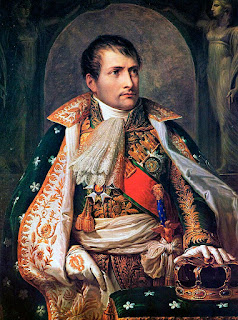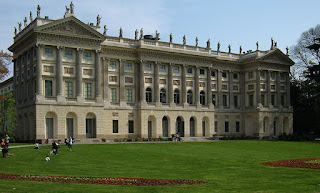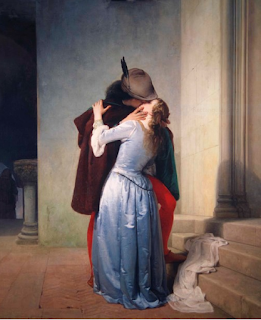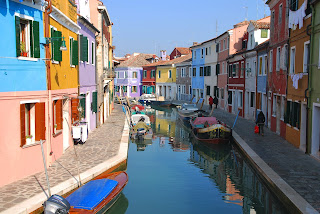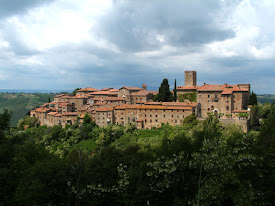Artist known for socially conscious themes
 |
| Morbelli, pictured in this self-portrait, highlighted social issues in his work |
Initially a painter of landscapes and historical scenes, he switched quite early in his career to contemporary subjects, many of which reflected his own social concerns. He had a particular interest in the lives of the elderly and the fate of the women who laboured in the region’s rice fields.
He was a proponent of the Divisionist style of painting that was founded in the 1880s by the French post-Impressionist Georges Seurat. In Divisionism, rather than physically blending paints to produce variations in colour, the painter constructed a picture from separate dots of paint that by their proximity would produce an optical interaction. Divisionists believed this technique achieved greater luminosity of colour.
Morbelli developed his painting as a student at the prestigious Brera Academy in Milan but his original ambitions had been in the field of music.
The son of a wealthy vineyard owner from Casale Monferrato, about 35km (22 miles) north of Alessandria, Morbelli had shown a remarkable aptitude for the flute but was forced by illness into a change of direction. At the age of seven, he contracted mastoiditis, a serious ear infection that caused him to suffer permanent hearing loss.
His parents instead encouraged him instead to study drawing, which quickly revealed a different talent, which would in time win him a scholarship granted by the Municipality of Alessandria to move to Milan and enrol at the Brera, where he studied under Giuseppe Bertini, Raffaele Casnedi and Luigi Riccardi, three renowned professors.
 |
| Morbelli's Giorni...ultimi, painted at the Pio Albergo Trivulzio retirement home, is one of his greatest works |
Around 1883, Morbelli shifted his focus to contemporary subjects. Notably, he depicted elderly residents of the Pio Albergo Trivulzio, a retirement home and hospital in Milan that was founded in the 18th century following a bequest from Tolomeo Trivulzio, a Milanese aristocrat.
Morbelli’s series of paintings from the home included Giorni…ultimi (Last Days), which earned him a Gold Medal at the Exposition Universelle in Paris in 1889.
Early in the 1880s he married Maria Pagani, a woman with whom he would share the rest of his life. They had four children, inspiring him to paint several works on motherhood. He often painted Maria with the children at their house in Milan and in the garden of their summer residence, Villa Maria, at Colma di Rosignano Monferrato, in the hills above Casale Monferrato.
He began to experiment with Divisionism in around 1890, at first painting landscapes close to the Villa Maria.
 |
| Morbelli's Per ottanta centesimi highlighted the exploitation of female labour in the rice fields |
His painting Per ottanta centesimi (For Eighty Cents), which depicted groups of women, standing ankle deep in water, engaged in the back-breaking work of picking the rice, was awarded the Gold Medal at the 1897 International Exhibition in Dresden. He used photography to inform some of his work, which attracted criticism from some other painters.
The year that opened the millennium was important for Morbelli, who at the 1900 Exposition Universelle in Paris received another Gold Medal - and the award of the Legion of Honor - for Giorno di festa (Day of Celebration), another painting set in the Pio Albergo Trivulzio.
Between 1902 and 1903, continuing to ponder old age and death, Morbelli set up a studio in the rooms of the hospice, where he created Il Natale dei resta (The Christmas of the Remainers), part of a cycle entitled Il poema della vecchiaia (The Poem of Old Age). The painting presented a stark image of five men sitting in a hall partly lit by the sun, among many rows of empty benches.
Morbelli’s work in the early part of the 20th century returned to painting landscapes, with work ranging from a view of Milan’s Duomo to a boat on Lake Garda. His 1913 painting Angolo di giardino (Corner of the Garden), which offered a glimpse of the family villa in Colma, was noted for the vibrant luminous depth he gave to the countryside beyond the villa’s garden. Some of his last work was completed between 1914 and 1919 in the Usseglio valley, a mountainous area in the east of Piedmont, close to the border with France.
Between 1908 and 1903, Morbelli is said to have met Carlo Carrà and Umberto Boccioni, two important painters of the Italian Futurist movement. Divisionism was influential in the development of Futurism, whose proponents adopted some of its methods to help evoke the dynamism of the urban environment they sought to convey in their work
He was still active when, in 1919, he developed pneumonia, which led to his death in Milan on November 7, at the age of 66.
 |
| The Cattedrale dei Santi Pietro e Marco was consecrated in 1879, replacing an older church |
The historic city of Alessandria, about 90km (56 miles) southeast of Turin, became part of French territory after the army of Napoleon defeated the Austrians at the Battle of Marengo in 1800 on fields to the east of the city. Alessandria has a Museum of the Battle of Marengo in Via della Barbotta in the district of Spinetta Marengo. The city was ruled by the Kingdom of Sardinia for many years and is notable for the Cittadella di Alessandria, a star-shaped fort and citadel built in the 18th century, which covers more than 180 acres on a site just across the Tanaro river and is one of the best preserved fortifications of its type. It remained a military establishment until as recently as 2007 and now holds a permanent exhibition of about 1500 uniforms, weapons and memorabilia. The city's neoclassical Cattedrale dei Santi Pietro e Marco was built in between 1874 and 1879. Alessandria is also a rail hub for northern Italy. The railway station opened in 1850 to form part of the Turin to Genoa railway and now also has lines to many other towns and cities both in Piedmont and neighbouring Lombardy.
 |
| Submerged fields in the rice-growing area around the city of Vercelli |
Vercelli is best known as the centre of Italy’s rice production industry, with many of the surrounding fields in the vast Po plain submerged under water during the summer months. Rice has been cultivated in the area since the 15th century. One of Vercelli’s speciality dishes, panissa, is made from risotto rice and beans, with pork and red wine. The city, which has around 46,500 inhabitants, is some 85km (53 miles) west of Milan and about 75km (46 miles) northeast of Turin. It is reckoned to be built on the site of one of the oldest settlements in Italy, dating back to 600BC, and was home to the world's first publicly-funded university, which was opened in 1228 but folded in 1372. Vercelli’s Basilica of Sant'Andrea is regarded as one of the most beautiful and best-preserved Romanesque buildings in Italy. The city also has an amphitheatre from the Roman period.
Also on this day:
1610: The death of Renaissance painter Caravaggio
1871: The birth of painter Giacamo Balla
1884: The birth of Cardinal Alberto di Jorio, Vatican banker
1914: The birth of cycling star and secret war hero Gino Bartali
1933: The birth of William Salice, inventor of the Kinder Egg

